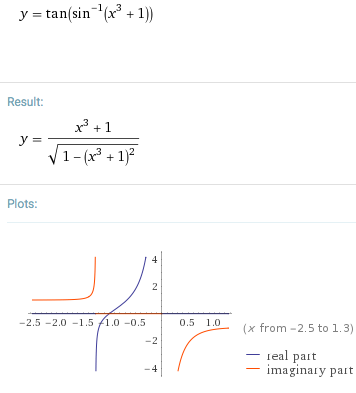#(dy)/(dx) = 3x^2(1+y^2)^(3/2)#?
This is a Calculus 2/3 question that I'm asking for a friend (I'm in Calculus 1).
This is a Calculus 2/3 question that I'm asking for a friend (I'm in Calculus 1).
3 Answers
See below.
Explanation:
To solve the differential equation we can use the property that it is a separable differential equation. So it can be rearranged as
After integrating both sides we obtain
# y^2 = (x^3+C)^2/(1-(x^3+C)^2) #
Explanation:
We have:
# (dy)/(dx) = 3x^2(1+y^2)^(3/2) #
We can collect term and for a separable differential equation:
# 1/(1+y^2)^(3/2) \ (dy)/(dx) = 3x^2 #
we can "seperate the variables" to get:
# int \ 1/(sqrt(1+y^2))^3 \ dy = int \ 3x^2 dx #
The RHS is trivially integrable, and the RHS will require a substitution, Let
# y = tan theta => dy/(d theta) = sec^2 theta #
Performing the substitution in the LHS integral, gives:
# int \ 1/(sqrt(1+y^2))^3 \ dy = int 1/(sqrt(1+tan^2theta))^3 \ sec^2theta \ d theta #
# " " = int sec^2 theta/(sqrt(sec^2theta))^3 \ d theta #
# " " = int sec^2 theta/sec^3theta \ d theta #
# " " = int 1/sectheta \ d theta #
# " " = int costheta \ d theta #
# " " = sintheta#
# " " = y/sqrt(1+y^2) #
And so returning to our above equation, and also integrating the RHS, we get:
# y/sqrt(1+y^2) = x^3+C #
We can, in this case, form an explicit solution for
# y = (x^3+C)sqrt(1+y^2) #
# :. y^2 = (x^3+C)^2(1+y^2) #
# :. \ \ \ \ = (x^3+C)^2+y^2(x^3+C)^2 #
# :. y^2(1-(x^3+C)^2) = (x^3+C)^2 #
# :. y^2 = (x^3+C)^2/(1-(x^3+C)^2) #
I got:
#y = tan(arcsin(x^3 + C))# ,#" "-1.25992 < x < 0#
For example,

Well, I'm assuming this is supposed to be about differential equations.
The common way to do this is via separation of variables:
#1/(1 + y^2)^(3//2)dy = 3x^2dx#
For this, let
#int (sec^2thetad theta)/((sqrt(1 + tan^2theta))^(3)) = int 3x^2dx#
#=> int cancel((sec^2theta)/(sec^3theta))^(costheta)d theta = int 3x^2dx#
This then gives:
#sintheta = x^3 + C#
Ideally you'd want to get this back into a function
#theta = arcsin(x^3 + C)#
Then, since
#arctany = arcsin(x^3 + C)#
#=> color(blue)(y = tan(arcsin(x^3 + C)))#
CHECK
Let's see if this even works. If it does, the derivative ought to give the right-hand side. Try taking the derivative with respect to
#(dy)/(dx) = sec^2(arcsin(x^3 + C)) cdot 1/(sqrt(1 - (x^3 + C)^2)) cdot 3x^2#
To simplify this,
#(x^3 + C)^2 + b^2 = 1^2#
The missing leg length is
#sec^2(arcsin(x^3 + C)) = 1/(cos^2(arcsin(x^3 + C)))#
#= 1/(cos(arcsin(x^3 + C)))^2# ,
we can simplify the derivative to:
#(dy)/(dx) = 1/(1 - (x^3 + C)^2) cdot 1/(sqrt(1 - (x^3 + C)^2)) cdot 3x^2#
#= (3x^2)/(1 - (x^3 + C)^2)^(3//2)#
We further wrote that
#= (3x^2)/(1 - sin^2theta)^(3//2)#
#= (3x^2)/(cos^2theta)^(3//2)#
#= 3x^2(sec^2theta)^(3//2)#
#= 3x^2(1 + tan^2theta)^(3//2)#
#= 3x^2(1 + y^2)^(3//2)# #color(blue)(sqrt"")#
Yep, our general solution works!



